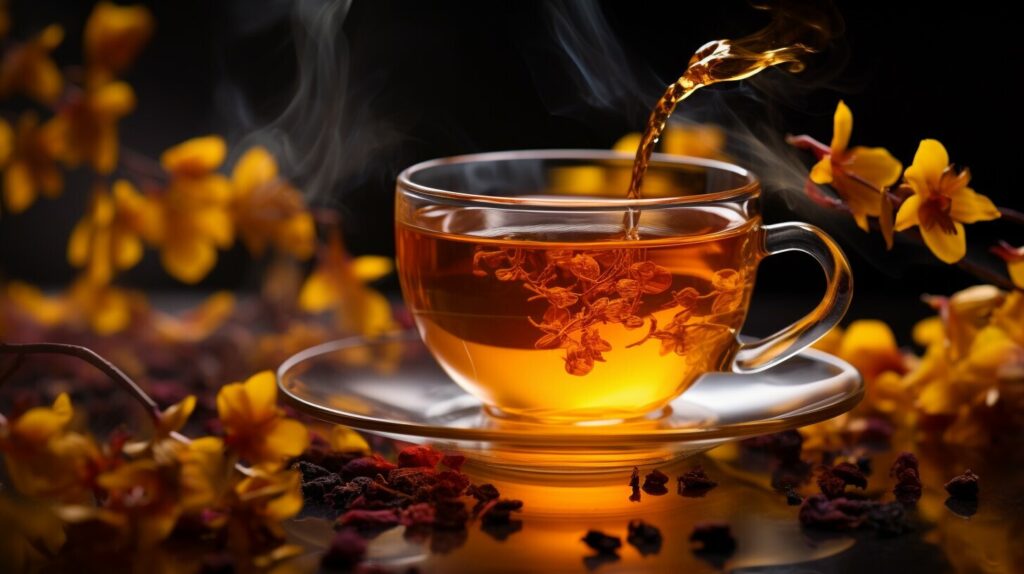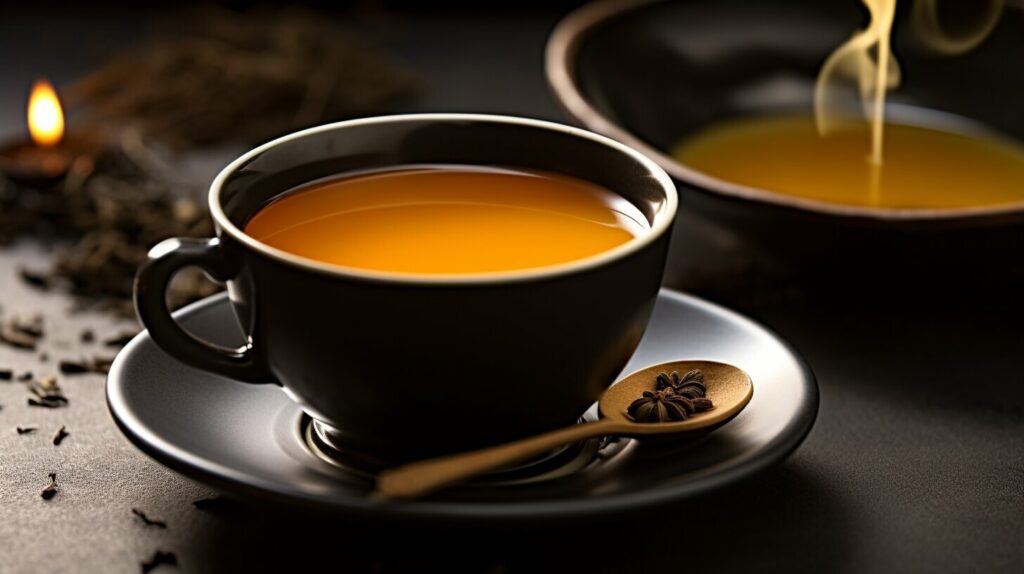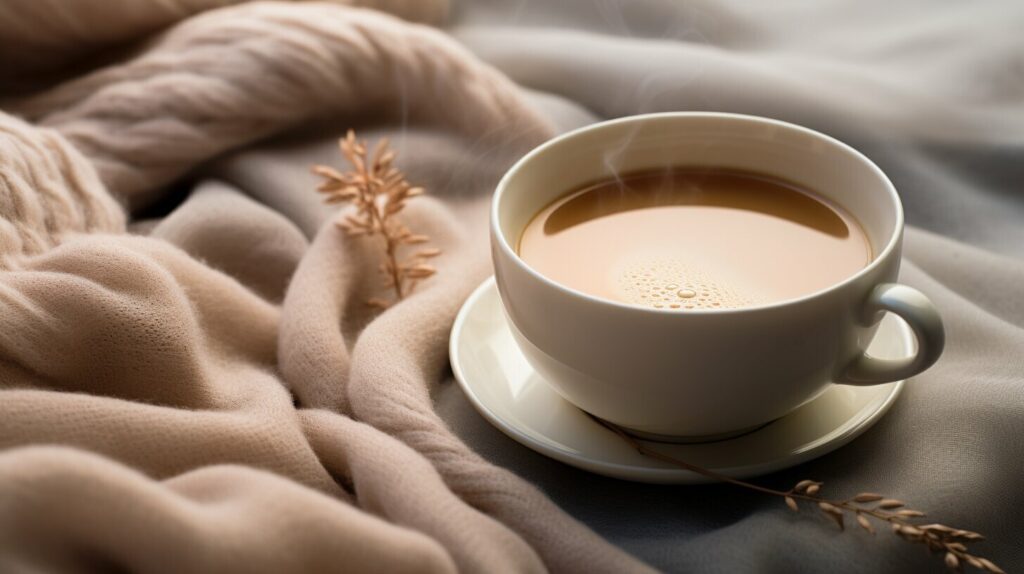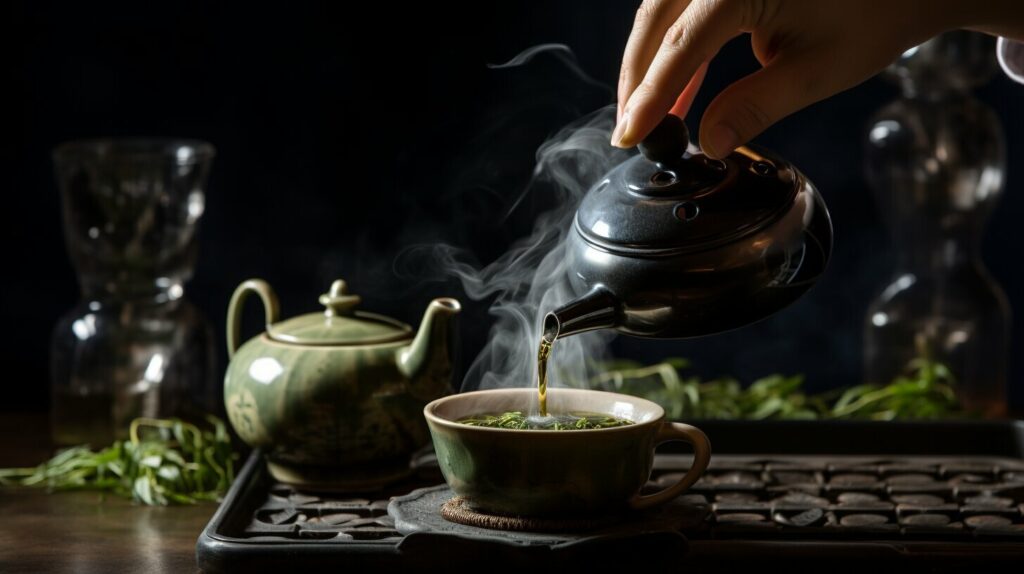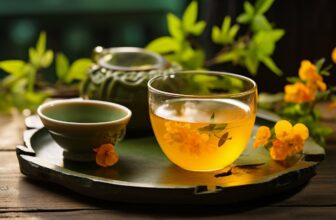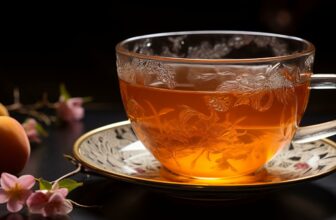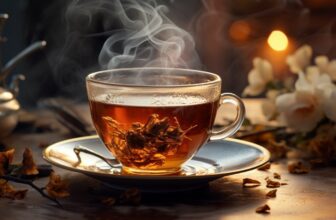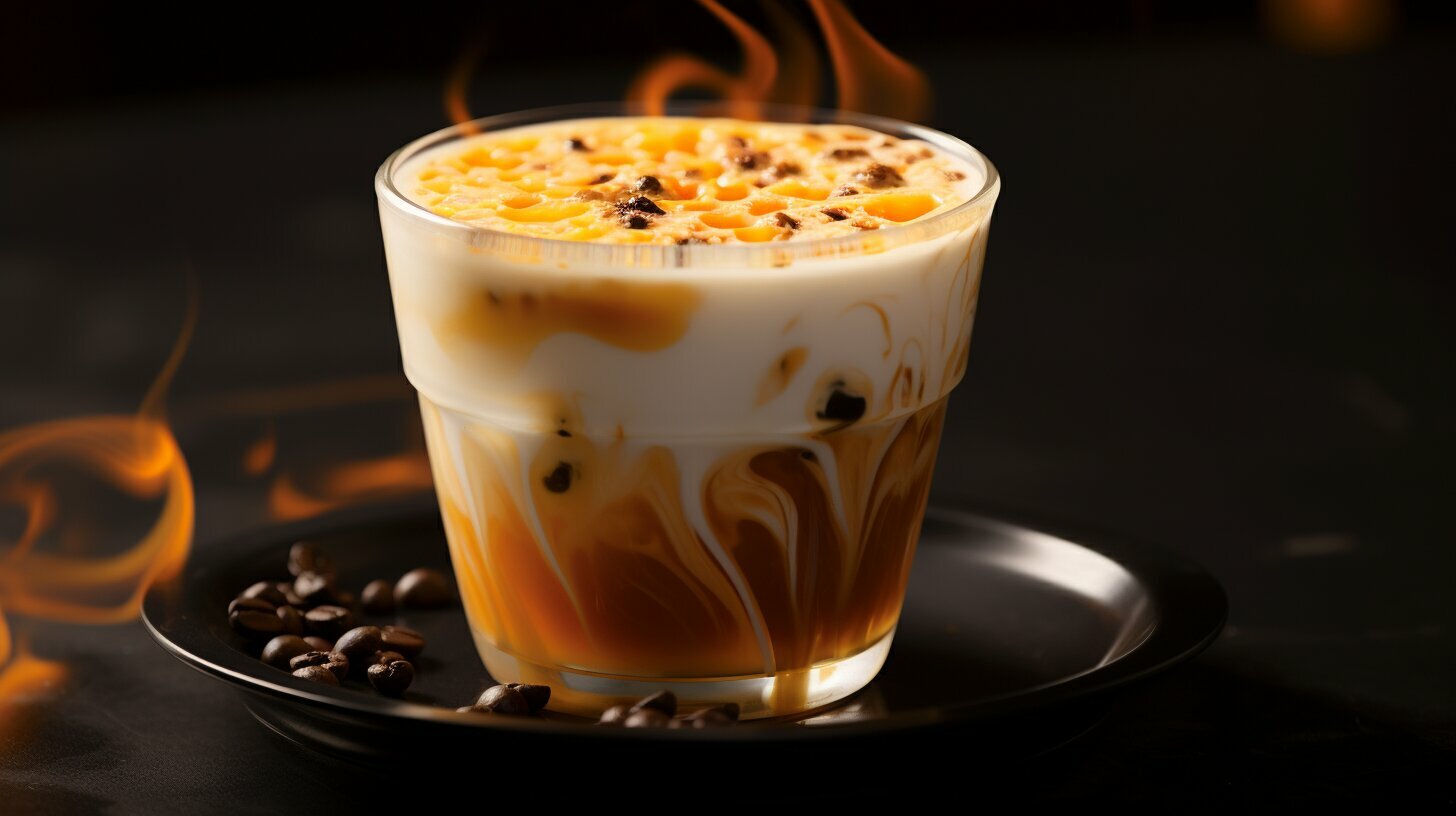
I’m here to guide you through the delightful world of oolong milk tea. If you’ve ever wondered what this indulgent beverage tastes like, you’re in the right place. Oolong milk tea offers a unique and satisfying flavor profile that combines floral and toasty notes, with a touch of creamy sweetness. The addition of milk adds a luxurious mouthfeel and enhances the natural complexities of oolong tea.
When sipping on a cup of oolong milk tea, you can expect a sensory experience like no other. The flavors dance on your palate, leaving a lingering aftertaste that will have you craving more of this decadent treat. So, let’s dive in and discover the taste, flavors, and characteristics that make oolong milk tea a truly exquisite beverage.
Key Takeaways:
- Oolong milk tea boasts a unique flavor profile with floral and toasty notes.
- The addition of milk brings a creamy richness and a touch of sweetness to the beverage.
- Oolong milk tea offers a sophisticated flavor experience and leaves a lingering aftertaste.
- The combination of oolong tea and milk creates a harmonious blend that is both comforting and refreshing.
- Prepare oolong milk tea by steeping high-quality oolong tea leaves and warming milk separately, then combining the two for the perfect blend.
What is Oolong Tea?
Oolong tea is a traditional Chinese tea that offers a unique flavor profile and falls between green and black tea in terms of oxidation. It undergoes a special oxidation process that gives it a range of flavors, from floral and fruity to toasty and nutty. Oolong tea is known for its complexity and is categorized into different varieties, each with its own distinct flavor characteristics.
During the production of oolong tea, the leaves are partially oxidized, resulting in a leaf style that is between the tightly rolled green tea leaves and fully oxidized black tea leaves. This unique oxidation process contributes to the diverse flavors found in oolong tea. The degree of oxidation varies depending on the desired flavor profile, with lighter oolongs having more delicate flavors and darker oolongs possessing a deeper, richer taste.
The flavors of oolong tea can range from floral notes, such as orchid and jasmine, to fruity hints, like peach and plum. Additionally, oolong tea can exhibit toasty notes, similar to roasted grains or nuts. The combination of these flavors creates a complex and satisfying drinking experience. The brewing process also plays a crucial role in bringing out the best flavors of oolong tea, allowing tea enthusiasts to fully appreciate its unique taste.
Table: Varieties of Oolong Tea
| Variety | Flavor Profile |
|---|---|
| Tie Guan Yin | Floral, buttery, and fruity |
| Dong Ding | Toasty, nutty, and caramelized |
| Wuyi Rock | Mineral, roasted, and smoky |
| Alishan | Floral, creamy, and sweet |
Each variety of oolong tea offers a different flavor profile, allowing tea connoisseurs to explore and discover their preferred taste. Whether you prefer a delicate floral tea or a robust and toasty one, there is an oolong tea variety to suit every palate.
The Flavors of Oolong Tea
Oolong tea offers a unique and complex flavor profile that sets it apart from other teas. It is known for its delightful combination of floral, fruity, and toasty notes, making each sip a sensory journey. The flavor of oolong tea is a delicate balance of these elements, creating a harmonious and satisfying experience.
When it comes to floral notes, oolong tea showcases hints of orchid, jasmine, and osmanthus, adding elegance and fragrant aromas to the tea. These floral undertones contribute to the soothing and refreshing qualities of oolong tea, making it a perfect choice for relaxation.
In addition to the floral notes, oolong tea also boasts fruity flavors that range from mild to more pronounced. Some oolong teas have fruity notes reminiscent of peaches, apricots, or even tropical fruits like pineapple. These fruity nuances add a refreshing and juicy dimension to the tea, making it a delightful choice for those who appreciate a touch of sweetness in their cup.
Finally, oolong tea offers toasty notes that give it a unique depth and complexity. This toasty flavor may remind you of roasted nuts or caramelized sugar, providing a rich and comforting sensation. The combination of floral, fruity, and toasty notes, along with a subtle sweetness, makes oolong tea a truly versatile and satisfying drink.
Table: Oolong Tea Flavor Profile
| Flavor Notes | Description |
|---|---|
| Floral | Hints of orchid, jasmine, and osmanthus contribute to the tea’s soothing and refreshing qualities. |
| Fruity | Offers a range of fruit flavors, from mild peaches and apricots to tropical fruits like pineapple. |
| Toasty | Delivers a rich and comforting sensation reminiscent of roasted nuts or caramelized sugar. |
| Subtle Sweetness | A gentle touch of sweetness that complements and balances the other flavor notes. |
Each cup of oolong tea is a delightful exploration of flavors, inviting you to savor the nuances and enjoy a truly unique tea experience. Whether you prefer the floral, fruity, or toasty notes, oolong tea offers a range of flavors that caters to every taste preference.
The Creamy Richness of Milk
Adding milk to oolong tea brings a creamy richness that balances the natural flavors. It creates a smooth and indulgent beverage with a luxurious mouthfeel. The type of milk used can vary, allowing for personalization of the oolong milk tea experience. The addition of milk also provides essential nutrients such as calcium and protein, making it a nourishing choice.
When it comes to oolong milk tea, the choice of milk can significantly impact the taste and texture of the drink. Dairy milk, such as whole milk or half-and-half, lends a rich and velvety consistency. Non-dairy alternatives like almond milk or oat milk offer a lighter and nuttier flavor profile. These options make oolong milk tea accessible to individuals with dietary restrictions or preferences.
The combination of oolong tea and milk creates a delightful interplay of flavors. The inherent sweetness of the tea is complemented by the smoothness of milk, resulting in a harmonious blend. The addition of milk also serves to mellow out any potential bitterness in the tea, allowing the intricate flavors of oolong to shine through. Whether you prefer the creaminess of dairy milk or the subtle nuttiness of non-dairy alternatives, adding milk elevates the oolong tea experience to new heights.
The Benefits of Adding Milk to Oolong Tea
Incorporating milk into oolong tea not only enhances the taste but also provides several benefits. Milk is an excellent source of calcium, which promotes strong bones and teeth. It also contains protein, which aids in muscle repair and growth. By adding milk to oolong tea, you can enjoy a nourishing and satisfying beverage that supports your overall well-being.
Furthermore, the creamy richness of milk adds a comforting element to oolong tea. This luxurious combination creates a soothing experience that can help you unwind and relax. Whether enjoyed in the morning to start your day or as an afternoon pick-me-up, oolong milk tea offers a comforting and indulgent treat that can be enjoyed any time.
| Milk Variety | Flavor Profile | Texture |
|---|---|---|
| Dairy Milk (Whole) | Rich, Creamy | Velvety |
| Dairy Milk (Skim) | Light, Subtle | Delicate |
| Almond Milk | Nutty, Sweet | Smooth |
| Oat Milk | Mild, Oat-like | Silky |
The Perfect Blend: Oolong and Milk
The combination of oolong tea and milk creates a delightful fusion of flavors that enhances the overall satisfaction of the beverage. The natural sweetness of oolong tea harmonizes perfectly with the creamy richness of milk, resulting in a smooth and indulgent experience. This unique blend elevates the flavor profile of oolong tea, bringing out its subtle nuances and creating a velvety texture that is incredibly satisfying.
Blending oolong tea with milk not only enhances the taste but also adds to the overall sensory experience. The addition of milk creates a silky mouthfeel that complements the floral and toasty notes of oolong tea. The combination of these elements provides a harmonious balance that is both comforting and refreshing.
There are several benefits to blending oolong tea with milk. The creamy texture of the milk softens the slightly astringent quality of oolong tea, making it more palatable for those who prefer a milder taste. Additionally, the addition of milk adds a touch of sweetness, reducing the need for additional sweeteners. This makes oolong milk tea a healthier alternative to other sugary beverages.
Achieving the Perfect Blend
To achieve the perfect blend of oolong tea and milk, it is important to use high-quality ingredients. Start by steeping your preferred oolong tea leaves in hot water for a few minutes, allowing the flavors to infuse. In a separate saucepan, warm up your choice of milk, whether it be dairy or non-dairy. Once the tea is ready, strain it and pour the warm milk over it, gently stirring to combine the flavors. The result is a harmonious blend of oolong tea and milk that offers a luxurious and satisfying taste experience.
The combination of oolong tea and milk is truly a match made in heaven. The richness of the milk enhances the natural flavors of oolong tea, resulting in a decadent and indulgent beverage that is sure to please the palate. Whether enjoyed hot or cold, oolong milk tea is a satisfying treat that brings together the best of both worlds.
A Comforting and Refreshing Drink
Oolong milk tea is not just a beverage; it is a comforting and refreshing experience. The unique combination of flavors in oolong milk tea creates a harmonious blend that tantalizes the taste buds and soothes the soul. With its earthy and floral notes, coupled with the creamy sweetness of milk, every sip brings a moment of tranquility and indulgence. Whether enjoyed as a morning pick-me-up or an evening treat, oolong milk tea is a delightful drink that provides comfort and refreshment.
The flavor profile of oolong milk tea is truly remarkable. The natural richness of oolong tea, with its floral and toasty notes, is enhanced by the creamy texture of milk. The result is a silky and smooth beverage that envelops the palate with layers of flavor. The balanced combination of earthiness and sweetness makes oolong milk tea a truly satisfying drink.
Not only does oolong milk tea offer a comforting taste experience, but it also provides a soothing effect on the senses. The warmth of the tea combined with the velvety texture of the milk creates a sense of coziness and relaxation. Each sip brings a moment of respite from the hustle and bustle of everyday life, allowing you to savor the flavors and find solace in the simple pleasure of a warm cup of oolong milk tea.
In summary, oolong milk tea is a comforting and refreshing drink that offers a unique flavor profile and a soothing experience. Its combination of earthy and floral notes, coupled with the creamy sweetness of milk, creates a harmonious blend that satisfies the senses. Whether enjoyed for its taste or as a moment of relaxation, oolong milk tea is a beverage that brings comfort and refreshment.
How to Prepare Oolong Milk Tea
Preparing oolong milk tea is a simple process that involves steeping high-quality oolong tea leaves and warming milk separately. Here is a step-by-step guide:
Step 1: Steeping Oolong Tea
Start by boiling water and allowing it to cool for a minute to reach the ideal temperature of around 180°F (82°C). Measure the desired amount of oolong tea leaves (approximately 1 tablespoon per cup) and place them in a teapot or infuser. Pour the hot water over the tea leaves and let it steep for 3 to 5 minutes to extract the flavors and aromas. Adjust the steeping time based on your preference for a stronger or milder taste.
Step 2: Warming Milk
In a separate saucepan, heat the milk on low to medium heat until it reaches a gentle simmer. Be cautious not to let it boil, as it can scorch the milk or alter its flavor. Stir occasionally to prevent a film from forming on the surface. Alternatively, you can warm the milk in a microwave-safe container in short intervals, stirring in between, until it is warm but not boiling.
Step 3: Combining Oolong Tea and Milk
Once the tea is steeped to perfection, strain it to remove the tea leaves. Pour the warm milk over the tea, gently stirring to blend the flavors. This step ensures that the milk and tea are integrated harmoniously, creating a smooth and creamy texture. Adjust the milk-to-tea ratio based on your preference, adding more or less milk to achieve the desired richness.
Enjoy your homemade oolong milk tea as a delightful treat or comforting beverage. Experiment with different variations by incorporating flavored syrups or sweeteners to personalize your drink further.
Variations of Oolong Milk Tea
When it comes to oolong milk tea, the possibilities are endless. This delightful beverage offers a plethora of variations, each with its own unique flavor profile. From fruity infusions to indulgent sweeteners, there is a variation to suit every palate. Let’s explore some of the most popular oolong milk tea variations:
Fruity Delights
One popular variation of oolong milk tea is the addition of fruity syrups. Whether it’s the tangy sweetness of passion fruit or the refreshing notes of peach, these fruity infusions create a burst of flavor that complements the oolong tea’s natural complexities. The combination of the floral and toasty oolong flavors with the bright and vibrant fruit syrups offers a truly delightful and invigorating taste experience.
Decadent Sweeteners
If you have a penchant for indulgence, you’ll love the variations of oolong milk tea that incorporate decadent sweeteners. The addition of honey or brown sugar adds richness and depth to the tea, creating a luscious and satisfying flavor profile. These sweeteners enhance the natural sweetness of the oolong tea while imparting a caramel-like undertone that elevates the overall taste.
Herbal Infusions
For those looking for a caffeine-free alternative, oolong milk tea can also be enjoyed with herbal infusions. Variations such as lavender or chamomile infusions offer a soothing and calming experience, perfect for moments of relaxation. These herbal infusions add a delicate floral note that complements the oolong tea’s inherent floral characteristics, creating a harmonious blend that is both comforting and refreshing.
| Variation | Description |
|---|---|
| Fruity Delights | Addition of fruity syrups such as passion fruit or peach, creating a burst of tangy sweetness that complements the floral and toasty oolong flavors. |
| Decadent Sweeteners | Incorporation of honey or brown sugar for a rich and indulgent flavor profile, elevating the natural sweetness of the oolong tea. |
| Herbal Infusions | Enjoyment with herbal infusions like lavender or chamomile, providing a soothing and calming experience that harmonizes with the oolong tea’s floral characteristics. |
Health Benefits of Oolong Milk Tea
Drinking oolong milk tea not only satisfies your taste buds but also offers numerous health benefits. This delightful blend of oolong tea and creamy milk provides a rich source of antioxidants that can help strengthen your immune system and reduce inflammation in the body.
Oolong tea is packed with polyphenols, which have been shown to have a positive impact on digestion. Consuming oolong milk tea after a meal can aid in the breakdown of food and promote better digestion. It can also help reduce bloating and improve gut health.
Additionally, the combination of oolong tea and milk can have a positive effect on skin health. Oolong tea contains antioxidants that help protect the skin from free radicals, which can cause premature aging and damage. The hydrating properties of milk can also contribute to a youthful and glowing complexion.
| Health Benefits of Oolong Milk Tea |
|---|
| Provides antioxidants |
| Aids in digestion |
| Promotes skin health |
Enjoying a cup of oolong milk tea not only offers a delightful sensory experience but also provides potential health benefits. The antioxidants, digestion-aiding properties, and skin-enhancing effects make this beverage a smart and enjoyable choice for both tea enthusiasts and health-conscious individuals.
Conclusion
In conclusion, oolong milk tea offers a unique and indulgent flavor profile that combines floral and toasty notes. The addition of creamy milk enhances the taste, providing a touch of sweetness that elevates the overall sensory experience. With its rich complexities and lingering aftertaste, oolong milk tea is a decadent treat worth savoring.
Oolong tea, with its intermediate level of oxidation, brings a range of flavors that can be described as floral, fruity, and toasty. It is a more complex and nuanced alternative to green tea, offering a refreshing and soothing experience. The subtle sweetness of oolong tea, complemented by hints of orchid, jasmine, and osmanthus, creates a harmonious blend that satisfies the palate.
Preparing oolong milk tea involves steeping high-quality oolong tea leaves in hot water, and then pouring warm milk over the tea to combine the flavors. The process is straightforward and can be personalized with various milk choices, including dairy or non-dairy options. The result is a comforting and refreshing beverage that provides a moment of tranquility and indulgence.
In addition to its exquisite taste, oolong milk tea also offers potential health benefits. It is rich in antioxidants, polyphenols, and vitamins, which strengthen the immune system, reduce inflammation, promote digestion, and contribute to skin health. By combining the goodness of oolong tea with the nourishing properties of milk, oolong milk tea becomes a satisfying choice for both taste and well-being.
FAQ
What does oolong milk tea taste like?
Oolong milk tea has a unique and indulgent flavor profile with a perfect balance of floral and toasty notes. The addition of creamy milk enhances the taste and adds a touch of sweetness.
What is oolong tea?
Oolong tea is a traditional Chinese tea that falls between green and black tea in terms of oxidation. It undergoes a unique oxidation process that gives it a range of flavors, from floral and fruity to toasty and nutty.
What are the flavors of oolong tea?
Oolong tea offers a unique combination of floral, fruity, and toasty notes. It has a subtle sweetness that is not overpowering, making it suitable for those who prefer a milder taste.
What does adding milk to oolong tea do?
Adding milk to oolong tea brings a creamy richness that balances the natural flavors. It creates a smooth and indulgent beverage with a luxurious mouthfeel.
How does the combination of oolong tea and milk taste?
The combination of oolong tea and milk results in a perfect harmony of flavors. The natural sweetness of oolong tea is enhanced by the creamy richness of milk, creating a smooth and satisfying beverage.
How do you prepare oolong milk tea?
To prepare oolong milk tea, steep high-quality oolong tea leaves in hot water for a few minutes. Warm up milk in a separate saucepan. Once the tea is ready, strain it and pour the warm milk over it, gently stirring to combine the flavors.
What are some variations of oolong milk tea?
Some popular variations of oolong milk tea include the addition of fruity syrups like passion fruit or peach, as well as ingredients like honey or brown sugar.
What are the health benefits of oolong milk tea?
Oolong milk tea is rich in antioxidants, polyphenols, and vitamins, which strengthen the immune system and reduce inflammation. It also promotes digestion and contributes to skin health.
More Links
